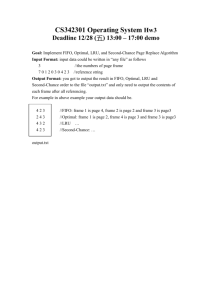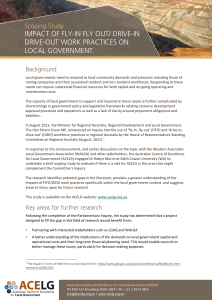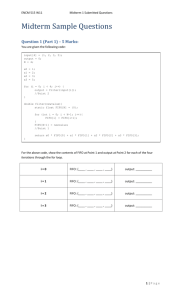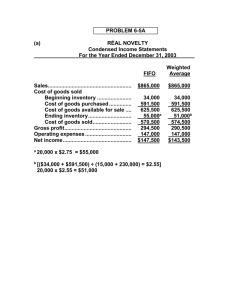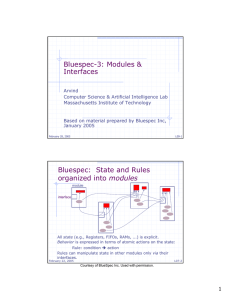Bluespec-2: Designing with Rules
advertisement
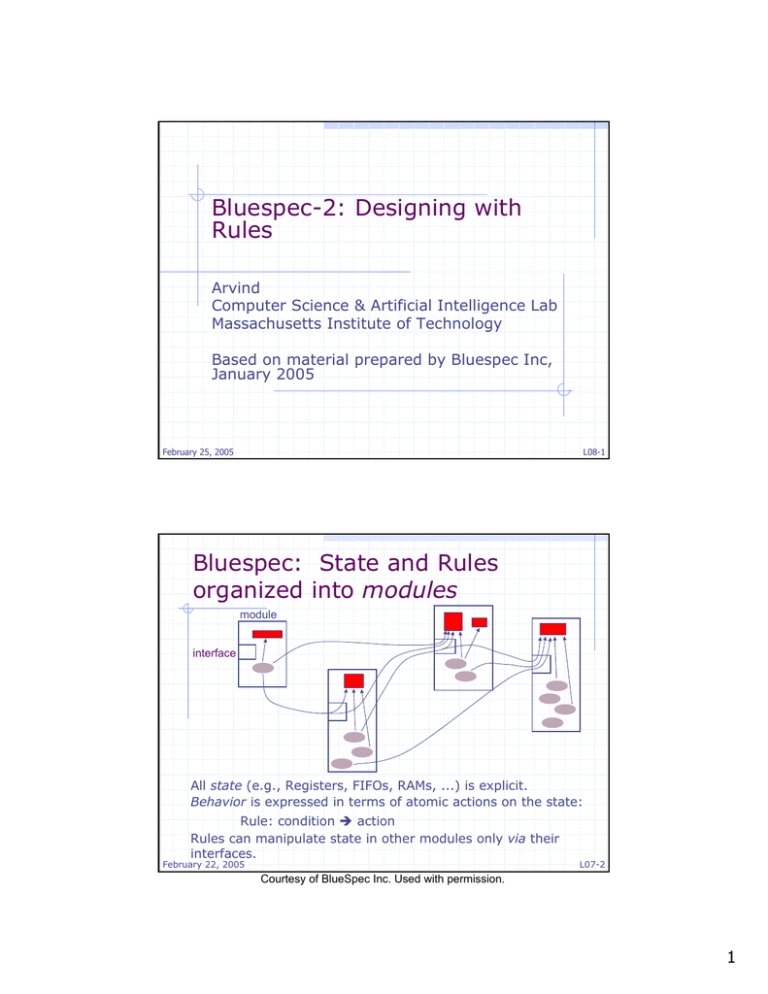
Bluespec-2: Designing with
Rules
Arvind
Computer Science & Artificial Intelligence Lab
Massachusetts Institute of Technology
Based on material prepared by Bluespec Inc,
January 2005
February 25, 2005
L08-1
Bluespec: State and Rules
organized into modules
module
interface
All state (e.g., Registers, FIFOs, RAMs, ...) is explicit.
Behavior is expressed in terms of atomic actions on the state:
Rule: condition Î action
Rules can manipulate state in other modules only via their
interfaces.
February 22, 2005
L07-2
Courtesy of BlueSpec Inc. Used with permission.
1
Rules
A rule is declarative specification of a
state transition
An action guarded by a Boolean condition
rule ruleName (<predicate>);
<action>
endrule
February 22, 2005
L07-3
Example 1:
simple binary multiplication
1001
x 0101
1001
0000
1001
0000
0101101
//
//
//
//
//
//
//
multiplicand (d) = 9
multiplier (r) = 5
d << 0 (since r[0] == 1)
0 << 1 (since r[1] == 0)
d << 2 (since r[2] == 1)
0 << 3 (since r[3] == 0)
product (sum of above) = 45
(Note: this is just a basic example; there are many sophisticated
algorithms for multiplication in the literature)
February 22, 2005
L07-4
2
Example 1:
simple binary multiplication
typedef bit[15:0] Tin;
typedef bit[31:0] Tout;
module mkMult0 ();
Tin d_init = 9, r_init = 5;
// compile-time constants
Reg#(Tout) product <- mkReg (0);
Reg#(Tout) d
<- mkReg ({16’h0000, d_init});
Reg#(Tin) r
<- mkReg (r_init);
State—registers
(module
instantiation)
rule cycle (r != 0);
if (r[0] == 1) product <= product + d;
d <= d << 1;
r <= r >> 1;
endrule: cycle
Behavior
rule done (r == 0);
$display (“Product = %d”, product);
endrule: done
endmodule: mkMult0
February 22, 2005
L07-5
Module Syntax
Module declarationmodule name
module mkMult0 ();
…
endmodule: mkMult0
Module instantiation
short form
interface
type
interface type’s
parameter(s)
Reg#(Tout)
interface
instance
module
name
module’s
parameter(s)
product
<- mkReg (0);
long form
Reg#(Tout)
mkReg#(0)
February 22, 2005
product(); // interface
the_product(product);
// the instance
L07-6
3
Variables
Variables have a type and name values
Tin d_init = 9, r_init = 5;
Variables never represent state
I.e., they do not remember values over time
They are always like wires, i.e., a variable
just represents the value it is assigned
State is obtained only by module
instantiation
February 22, 2005
L07-7
The module hierarchy
instance of mkMult0
product
d
r
instances of mkReg
As in Verilog, module instances can be nested,
i.e., the tree can be deeper.
All state elements are at the leaves
February 22, 2005
L07-8
4
Example 1 in Verilog RTL
module mkMult0 (CLK, RST_N);
input CLK;
input RST_N;
reg [31:0] product = 0;
reg [31:0] d
= 9;
reg [15:0] r
= 5;
ry
Ve
r!
ila
m
i
s
always @ (posedge CLK)
if (r != 0) begin
if (r[0] == 1) product <= product + d;
d <= d << 1;
r <= r >> 1;
end
else
$display (“Product = %d”, product);
endmodule: mkMult0
February 22, 2005
L07-9
Over-simplified
analogy with Verilog process
In this simple example, a rule is reminiscent of
an “always” block:
rule rname (<cond>); <action> endrule
always@(posedge CLK)
if (<cond>) begin: rname
<action>
end
But this is not true in general:
Rules have interlocks—becomes important when
rules share resources, to avoid race conditions
Rules can contain method calls, invoking actions in
other modules
February 22, 2005
L07-10
5
Rule semantics
Given a set of rules and an initial state
while ( some rules are applicable*
in the current state )
choose one applicable rule
apply that rule to the current state to
produce the next state of the system**
(*) “applicable” = a rule’s condition is true in current state
(**) These rule semantics are “untimed” – the action to change the state
can take as long as necessary provided the state change is seen as
atomic, i.e., not divisible.
February 22, 2005
L07-11
Example 2:
Concurrent Updates
Process 0 increments register x;
Process 1 transfers a unit from register x to register y;
Process 2 decrements register y
0
+1
-1
x
1
+1
-1
2
y
This is an abstraction of some real applications:
Bank account: 0 = deposit to checking, 1 = transfer from
checking to savings, 2 = withdraw from savings
Packet processor: 0 = packet arrives, 1 = packet is
processed, 2 = packet departs
…
February 22, 2005
L07-12
6
Concurrency in Example 2
0
+1
-1
x
1
+1
-1
2
y
Process j (= 0,1,2) only updates under
condition condj
Only one process at a time can update a
register. Note:
Process 0 and 2 can run concurrently if process 1 is
not running
Both of process 1’s updates must happen
“indivisibly” (else inconsistent state)
Suppose we want to prioritize process 2 over
process 1 over process 0
February 22, 2005
L07-13
Example 2 Using Rules
(* descending_urgency = “proc2, proc1, proc0” *)
rule proc0 (cond0);
x <= x + 1;
endrule
rule proc1 (cond1);
y <= y + 1;
x <= x – 1;
endrule
rule proc2 (cond2);
y <= y – 1;
endrule
Functional correctness follows
directly from rule semantics
Related actions are grouped
naturally with their conditions—
easy to change
Interactions between rules are
managed by the compiler
(scheduling, muxing, control)
February 22, 2005
L07-14
7
Example 2 in Verilog:
Explicit concurrency control
always @(posedge CLK) // process 0
if ((!cond1 || cond2) && cond0)
x <= x + 1;
will make it incorrect
always @(posedge CLK) // process 1
if (!cond2 && cond1) begin
y <= y + 1;
x <= x – 1;
end
always @(posedge CLK) begin
if (!cond2 && cond1)
x <= x – 1;
else if (cond0)
x <= x + 1;
if (cond2)
y <= y – 1;
else if (cond1)
r
y <= y + 1;
he
end
ot
n
tio
u
l
so
An
always @(posedge CLK) // process 2
if (cond2)
y <= y – 1;
Are these solutions correct?
How to verify that they’re correct?
What needs to change if the conds change?
What if the processes are in different modules?
February 22, 2005
L07-15
A FIFO interface
interface FIFO #(type t);
method Action enq(t);
method Action deq();
method t
first();
method Action clear();
endinterface: FIFO
//
//
//
//
enqueue an item
remove oldest entry
inspect oldest item
make FIFO empty
n
rdy
enab
n
February 22, 2005
FIFO
module
not empty
first
enq
enab
rdy
deq
not empty
clear
not full
enab
rdy
n = # of bits needed
to represent the
values of type “t“
L07-16
8
Actions that return Values:
Another FIFO interface
not empty
enab
rdy
not empty
rdy
first
pop
n
enab
clear
not full
n
FIFO
module
n
enab
rdy
push
interface FIFO #(type t);
method Action push(t);
method ActionValue#(t) pop();
method t
first();
method Action clear();
endinterface: FIFO
//
//
//
//
enqueue an item
remove oldest entry
inspect oldest item
make FIFO empty
n = # of bits needed
to represent the
values of type “t“
February 22, 2005
L07-17
Packets arrive on
two input FIFOs, and
must be switched to
two output FIFOs
dest(pkt) ∈ {1,2}
Certain “interesting
packets” must be
counted
o1
o2
i2
Determine
Queue
i1
Determine
Queue
Example 3:
A 2x2 switch, with stats
interesting(pkt) ∈
{True, False}
+1
Count
certain packets
February 22, 2005
L07-18
9
Example 3: Specifications
Input FIFOs can be empty
Output FIFOs can be full
Shared resource collision on an output FIFO:
if packets available on both input FIFOs, both have same
destination, and destination FIFO is not full
Shared resource collision on counter:
if packets available on both input FIFOs, each has different
destination, both output FIFOs are not full, and both
packets are “interesting”
Resolve collisions in favor of packets from the first input
FIFO
Must have maximum throughput: a packet must move if
it can, modulo the above rules
February 22, 2005
L07-19
Determine
Queue
(* descending_urgency = "r1, r2" *)
// Moving packets from input FIFO i1
rule r1;
Tin x = i1.first();
if (dest(x)== 1) o1.enq(x);
else
o2.enq(x);
i1.deq();
if (interesting(x)) c <= c + 1;
endrule
Determine
Queue
Rules for Example 3
+1
// Moving packets from input FIFO i2
rule r2;
Tin x = i2.first();
if (dest(x)== 1) o1.enq(x);
else
o2.enq(x);
i2.deq();
if (interesting(x)) c <= c + 1;
endrule
February 22, 2005
Count
certain packets
Notice, the rules
have no explicit
predicates, only
actions
L07-20
10
Example 3: Commentary
Muxes and their control for output FIFOs and
Counter are generated automatically
FIFO emptiness and fullness are handled
automatically
Rule and interface method semantics make it
Impossible to read a junk value from an empty FIFO
Impossible to enqueue into a full FIFO
Impossible to race for multiple enqueues onto a FIFO
No magic -- equally available for user-written
module interfaces
All control for resource sharing handled
automatically
Rule atomicity ensures consistency
The “descending_urgency” attribute resolves
collisions in favor of rule r1
February 22, 2005
L07-21
Example 3: Changing Specs
Now imagine the following changes to the
existing code:
Some packets are multicast (go to both FIFOs)
Some packets are dropped (go to no FIFO)
More complex arbitration
FIFO collision: in favor of r1
Counter collision: in favor of r2
Fair scheduling
Several counters for several kinds of interesting
packets
Non-exclusive counters (e.g., TCP Î IP)
M input FIFOs, N output FIFOs (parameterized)
Suppose these changes are required 6 months
after original coding
Rules based designs provide flexibility, robustness,
correctness, ...
February 22, 2005
L07-22
11
Example 4: Shifter
Goal: implement:
y = shift (x,s)
where y is x shifted by s positions.
Suppose s is a 3-bit value.
Strategy:
Shift by s =
shift by
and by
and by
4 (=22)
2 (=21 )
1 (=20 )
if s[2] is set,
if s[1] is set,
if s[0] is set
A shift by 2j is trivial: it’s just a “lane change” made purely
with wires
sh2
0
0
February 22, 2005
L07-23
Cascaded Combinational
Shifter
s 3
s1
x1
sh4
x2
n
A family of
functions
sh2
f
s2
mux
x0
mux
sh1
mux
x n
s0
function Pair step_j (Pair sx);
where k=2j
return ((sx.s[j]==0) ? sx :
Pair{s: sx.s,x:sh_k(sx.x)});
endfunction
function int shifter (int s,int x);
Pair sx0, sx1, sx2;
sx0 = step_0(Pair{s:s, x:x});
sx1 = step_1(sx0);
typedef struct
sx2 = step_2(sx1);
{int x; int s;}
return (sx2.x);
Pair;
endfunction
February 22, 2005
L07-24
12
Asynchronous pipeline
with FIFOs (regs with interlocks)
s 3
s0
s2
fifo2
sh4
mux
fifo1
sh2
mux
fifo0
sh1
mux
x n
s1
n
fifo3
rule stage_1;
Pair sx0 <- fifo0.pop();
endrule
fifo1.push(step_0(sx0));
rule stage_2;
Pair sx1 <- fifo1.pop();
endrule
fifo2.push(step_1(sx1));
rule stage_3;
Pair sx2 <- fifo2.pop();
endrule
fifo3.push(step_2(sx2));
February 22, 2005
L07-25
Required simultaneity
If it is necessary for several
actions to happen together,
(i.e., indivisibly, atomically)
Put them in the same rule!
February 22, 2005
L07-26
13
Synchronous pipeline
(with registers)
s 3
[0]
sx1
step_1
step_2
rule sync-shifter;
sx1 <= step_0(sx0);
sx2 <= step_1(sx1);
sx3 <= step_2(sx2);
endrule
[2]
sx2
sh4
mux
sh2
mux
sx0
sh1
mux
x n
[1]
n
sx3
step_3
sx1, sx2 and sx3 are
registers defined
outside of the rules
February 22, 2005
L07-27
Discussion
In the synchronous pipeline, we compose
actions in parallel
All stages move data simultaneously, in lockstep
(atomic!)
In the asynchronous pipeline, we compose
rules in parallel
Stages can move independently (each stage can
move when its input fifo has data and its output fifo
has room)
If we had used parallel action composition instead,
all stages would have to move in lockstep, and could
only move when all stages were able to move
Your design goals will suggest which kind of
composition is appropriate in each situation
February 22, 2005
L07-28
14
Summary: Design using Rules
Much easier to reason about
correctness of a system when you
consider just one rule at a time
No problems with concurrency (e.g.,
race conditions, mis-timing,
inconsistent states)
We also say that rules are “interlocked”
Î Major impact on design entry time and
on verification time
February 22, 2005
L07-29
Types and Syntax notes
February 22, 2005
L07-30
15
Types and type-checking
BSV is strongly-typed
Every variable and expression has a type
The Bluespec compiler performs strong type
checking to guarantee that values are
used only in places that make sense,
according to their type
This catches a huge class of design
errors and typos at compile time, i.e.,
before simulation!
February 22, 2005
L07-31
SV notation for types
Some types just have a name
int, Bool, Action, …
More complex types can have
parameters which are themselves
types
FIFO#(Bool)
Tuple2#(int,Bool)
FIFO#(Tuple2#(int,Bool))
February 22, 2005
//
//
//
//
fifo containing Booleans
pair of items: an int and a Boolean
fifo containining pairs of ints
and Booleans
L07-32
16
Numeric type parameters
BSV types also allows numeric
parameters
Bit#(16)
Int#(29)
Vector#(16,Int#(29))
// 16-bit wide bit-vector
// 29-bit wide signed integers
// vector of 16 Int#(29) elements
These numeric types should not be
confused with numeric values, even
though they use the same number
syntax
The distinction is always clear from context, i.e.,
type expressions and ordinary expressions are
always distinct parts of the program text
February 22, 2005
L07-33
Courtesy of BlueSpec Inc. Used with permission.
A synonym for bit-vectors:
Standard Verilog notation for bitvectors is just special syntax for
the general notation
bit[15:0]
February 22, 2005
is the same as
Bit#(16)
L07-34
17
Common scalar types
Bool
Booleans
Bit#(n)
Bit vectors, with a width n bits
Int#(n)
Signed integers of n bits
UInt#(n)
Unsigned integers of n bits
February 22, 2005
L07-35
Types of variables
Every variable has a data type:
bit[3:0] vec;
// or
Bit#(4) vec;
vec = 4’b1010;
Bool cond = True;
typedef struct { Bool b; bit[31:0] v; } Val;
Val x = { b: True, v: 17 };
BSV will enforce proper usage of values
according to their types
You can't apply “+” to a struct
You can’t assign a boolean value to a
variable declared as a struct type
February 22, 2005
L07-36
18
“let” and type-inference
Normally, every variable is introduced
in a declaration (with its type)
The “let” notation introduces a variable
with an assignment, with the compiler
inferring its correct type
let vec = 4’b1010;
// bit[3:0] vec = …
let cond = True;
// Bool cond = …;
This is typically used only for very
“local” temporary values, where the
type is obvious from context
February 22, 2005
L07-37
Instantiating
interfaces and modules
The SV idiom is:
Instantiate an interface
Instantiate a module, binding the interface
Note: the module instance name is generally not
used, except in debuggers and in hierarchical
names
interface type
interface instance declaration
module instance declaration
interface type’s
parameters
interface instance
FIFO#(DataT)
inbound1();
mkSizedFIFO#(fifo_depth) the_inbound1(inbound1);
module name
module
parameters
module instance
BSV also allows a shorthand:
FIFO#(DataT) inbound1 <- mkSizedFIFO(fifo_depth);
February 22, 2005
L07-38
19
Rule predicates
The rule predicate can be any Boolean
expression
Including function calls and method calls
Cannot have a side-effect
This is enforced by the type system
The predicate must be true for rule
execution
But in general, this is not enough
Sharing resources with other rules may
constrain execution
February 22, 2005
L07-39
Why not “ reg x; ”?
Unambiguity: In V and SV, “reg x;” is
a variable declaration which may or
may not turn into a HW register
Uniformity: BSV uses SV’s moduleinstantiation mechanism uniformly for
primitives and user-defined modules
Strong typing: Using SV’s moduleinstantiation mechanism enables
polymorphic, strongly-typed registers
February 22, 2005
L07-40
20
